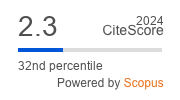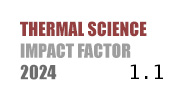THERMAL SCIENCE
International Scientific Journal
EXPLORING THE COMBUSTION CHARACTERISTICS OF TURBULENT PREMIXED AMMONIA/HYDROGEN/AIR FLAMES VIA DTF MODEL-BASED LARGE EDDY SIMULATION
ABSTRACT
This study aims to investigate the combustion characteristics of a premixed swirl flame for a fuel mixture made of NH3 and H2. The use of NH3 and H2 as carbon-free fuels in combustion systems can significantly reduce GHG emissions. Blending NH3 with H2 is a promising approach to enhance H2 combustion safety and NH3 combustion intensity. A 3-D large eddy simulation using a dynamically thickened flame (DTF) model was run in order to get extensive and multi-scale information regarding the flow and reacting field of a premixed swirl flame using a 50% NH3 50% H2 fuel blend. The findings indicate that whereas NO is created near the flame front, OH radicals are mostly synthesized in the inner re-circulation zone. The fuel-NO pathway, which is sensitive to flame temperature, is what causes NO to be produced. The flame position is where the re-circulation zone lies, and the total re-circulation strength is determined by the inner re-circulation strength. The prediction of NO concentration by large eddy simulations, considering heat loss, is closer to the experimental value. The chemically reacting network simulation can precisely estimate NO emission by considering the heat loss ratio and the re-circulation strength calculated by large eddy simulations. Overall, this study provides valuable insights into the combustion characteristics of an NH3/H2 fuel blend, which could contribute to the development of cleaner and more efficient combustion technologies. The findings of this study can be of great significance in the fields of sustainable energy and environmental protection.
KEYWORDS
PAPER SUBMITTED: 2023-11-23
PAPER REVISED: 2024-06-27
PAPER ACCEPTED: 2024-12-18
PUBLISHED ONLINE: 2025-02-16
THERMAL SCIENCE YEAR
2025, VOLUME
29, ISSUE
Issue 1, PAGES [675 - 689]
- Chiuta, S., et al., Reactor Technology Options for Distributed Hydrogen Generation Via Ammonia Decomposition: A Review, Int. J. Hydrogen Energy, 38 (2013), 35, pp. 14968-14991
- Michalsky, R., et al., Solar Thermochemical Production of Ammonia from Water, Air and Sunlight: Thermodynamic and Economic Analyses, Energy, 42 (2010), 1, pp. 251-260
- Yang, S. J., et al., Recent Advances in Hydrogen Storage Technologies Based on Nanoporous Carbon Materials, Prog. Nat. Sci., 22 (2012), 6, pp. 631-638
- Verkamp, F. J., et al., Ammonia Combustion Properties and Performance in Gas Turbine Burners, Int. Symp. Combust., 11 (1967), 1, pp. 985-992
- Lee, J. H., et al., Effects of Ammonia Substitution on Hydrogen/Air Flame Propagation and Emissions, Int. J. Hydrogen Energy, 35 (2010), 20, pp. 11332-11341
- Kumar, P., et al., Experimental and Modelling Study of Chemical-Kinetics of Mechanisms for H2-NH3- Air Mixtures in Laminar Premixed Jet Flames, Fuel, 108 (2013), June, pp. 166-176
- Pratt, D. T., Performance of Ammonia Fired Gas Turbine Combustors, Report TR-9-TS-67-5, Solar, San Diego, Cal., USA, 1967
- Mathieu, O., et al., Experimental and Modelling Study on the Hightemperature Oxidation of Ammonia and Related NOx chemistry, Combust Flame, 162 (2015), 3, pp. 554-570
- Hayakawa, A., et al., Experimental Investigation of Stabilization and Emission Characteristics of Ammonia/Air Premixed Flames in a Swirl Combustor, Int. J. Hydrogen Energy, 42 (2017), 19, pp. 14010-14018
- Han, X. L., et al., Experimental and Kinetic Modelling Study of Laminar Burning Velocities of NH3/ Air, NH3/H2/air, NH3/CO/air and NH3/CH4/Air Premixed Flames, Combust Flame, 206 (2019), Aug., pp. 214-226
- Li, J., et al., Study on Using Hydrogen and Ammonia as Fuels: Combustion Characteristics and NOx Formation, Int. J. Energy Research, 38 (2014), 9, pp. 1214-1223
- Valera-Medina, A., et al., Preliminary Study on Lean Premixed Combustion of Ammonia-Hydrogen for Swirling Gas Turbine Combustors, Int. J. Hydrogen Energy, 42 (2017), 38, pp. 24495-24503
- Valera-Medina, A., et al., Premixed Ammonia/Hydrogen Swirl Combustion under Rich Fuel Conditions for Gas Turbines Operation, Int. J. Hydrogen Energy, 44 (2019), 16, pp. 8615-8626
- Franco, M. C., et al., Characteristics of NH3/H2/Air Flames in a Combustor Fired by a Swirl and Bluff- Body Stabilized Burner, Proc. Combust. Inst., 38 (2021), 4, pp. 5129-5138
- Somarathne, K. D. K. A., et al., Numerical Study of a Low Emission Gas Turbine Like Combustor for Turbulent Ammonia/Air Premixed Swirl Flames with a Secondary Air Injection at High Pressure, Int. J. Hydrogen Energy, 42 (2017), 44, pp. 27388-27399
- Okafor, E. C., et al., Towards the Development of An Efficient Low-NOx Ammonia Combustor for a Micro Gas Turbine, Proc. Combust. Inst., 37 (2018), 9, pp. 4597-4606
- Xiao, H., et al., The 3-D Simulation of Ammonia Combustion in a Lean Premixed Swirl Burner, Energy Procedia, 142 (2017), Dec., pp. 1294-1299
- Honzawa, T., et al., Predictions of NO and CO Emissions in Ammonia/Methane/Air Combustion by LES Using a Non-Adiabatic Flamelet Generated Manifold, Energy, 186 (2019), 115771
- Vigueras-Zuniga, M. O,. et al., Numerical Predictions of a Swirl Combustor Using Complex Chemistry Fueled with Ammonia/Hydrogen Blends, Energies, 13 (2020), 2, 288
- Valera-Medina, A., et al., Ammonia, Methane and Hydrogen for Gas Turbines, Energy Procedia, 75 (2015), Aug., pp. 118-123
- ***, OpenFOAM 1.7.1. 2010. Available at: openfoam.org/version/1-7-1/, 2010
- Runyon, J., et al., Methane-Oxygen Flame Stability in a Generic Premixed Gas Turbine Swirl Combustor at Varying Thermal Power and Pressure, Proceedings, ASME Turbo Expo, Montreal, Canada, 2015
- Butler, T. D., et al., A Numerical Method for 2-D Unsteady Reacting Flows, Proc. Combust. Inst., 16 (1977), 1, pp. 1503-1515
- Angelberger, C., et al., Large Eddy Simulation of Combustion Instabilities in Turbulent Premixed Flames, Proceedings of the Summer Program, 1998, pp. 61-82
- Colin, O., et al., A Thickened Flame Model for Large Eddy Simulations of Turbulent Premixed Combustion, Physics of Fluids, 12 (2000), 7, pp. 1843-1863
- Wang, P., et al., A Detailed Comparison of Two Sub-Grid Scale Combustion Models Via Large Eddy Simulation of the PRECCINSTA Gas Turbine Model Combustor, Combust Flame, 164 (2016), Feb., pp. 329-345
- Xiao, H., et al., Modelling Combustion of Ammonia/Hydrogen Fuel Blends under Gas Turbine Conditions, Energy Fuels, 31 (2017), 8, pp. 8631-8642
- Mao, C. L., et al., Laminar Flame Speed and NO Emission Characteristics of Premixed Flames with Different Ammonia-Containing Fuels, J. Chem. Ind. Eng. (China), 72 (2021), 10, pp. 5530-5543
- Goodwin, D. G., et al., Cantera. www.cantera.org
- ***, ANSYS CHEMKIN PRO version 18.1. www.ansys.com/products/fluids/ansys-chemkin-proANSYS
- Rocha, R. C. D., et al., Chemical Kinetic Modelling of Ammonia/Hydrogen/Air Ignition, Premixed Flame propagation and NO emission, Fuel, 246 (2019), June, pp. 24-33
- Kumar, P., Meyer, T. R., Experimental and Modelling Study of Chemical-Kinetics Mechanisms for H2-NH3-Air Mixtures in Laminar Premixed Jet Flames, Fuel, 108 (2013), June, pp. 166-176

